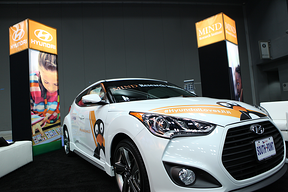
 As a nonprofit, MIND Research Institute and its philanthropic partners work with school districts to enable high-needs schools to participate in the ST Math program. These public-private partnerships are designed to address the need for public school systems to better prepare students to excel in math from a young age. Nearly 250,000 students across the country are benefiting from such partnerships, which include the participation of Hyundai Motor America, PricewaterhouseCoopers, W.M. Keck Foundation, Chevron, and others.
As a nonprofit, MIND Research Institute and its philanthropic partners work with school districts to enable high-needs schools to participate in the ST Math program. These public-private partnerships are designed to address the need for public school systems to better prepare students to excel in math from a young age. Nearly 250,000 students across the country are benefiting from such partnerships, which include the participation of Hyundai Motor America, PricewaterhouseCoopers, W.M. Keck Foundation, Chevron, and others.
Recently an educator and corporate partner spoke to EduTalk Radio about how one such partnership is benefiting students in our nation’s capital.
In case you missed the show, here are some aspects of what makes their public-private partnership work
Corporations Want to Give Back
Like many companies, Hyundai is motivated by a desire to make a positive difference through philanthropy and corporate social responsibility. “At Hyundai, we believe it’s important to give back to the communities in which we live and work,” said Brooks. “That’s what corporate social responsibility is ultimately about.” While acknowledging that no single company can fix every problem, Brooks said “we can certainly do our part to make the society a better place.”
CSR Visions Are Long-term
Through its CSR activities, Hyundai aims to improve high school graduation rates that will lead to a more qualified workforce down the road. To that end, Hyundai worked with MIND Research Institute to identify elementary schools that feed to high schools with a significant drop out rate. “We thought if we could talk to the kids at k-6, we might be able to impact and shape a life-long love of learning as well as having some early successes through the math program,” said Brooks.
Both Sides Are Committed
Rather than give grants away to schools to use ST Math, Hyundai wanted to focus on schools that were invested in their vision. Successful implementation of ST Math requires technology (e.g., computer labs, laptop carts, or tablets), time (at least 45 minutes twice a week using the program) and commitment from teachers and administrators. “We wanted to work with schools who had themselves invested in the work,” said Brooks. At Leckie Elementary, principal-in-training Butler says the students have access to the program every day, and at home. Teachers took training on how to use ST Math, and they thoroughly integrate the program into their math lessons.
Innovation Matters in Education
Brooks describes memorizing multiplication tables from flash cards and ultimately “regurgitating” the information when he was in elementary school. ST Math is different. “It helps the kids understand why six times four is 24 and communicates that in a language they already have – video games.”
ST Math Meets Children “Where They Are”
“One of the things that I particularly like about the MIND program is that it meets the kids where they are,” explains Brooks. “In our current environment, where video game technology is such a part of the American experience, [MIND Research Institute was] able to take the complexities of mathematics and associate with where kids are currently consuming information.”
The Program Can Be Scaled
“What we really enjoyed was that [ST Math] could be taken to scale,” said Brooks. “We can go into any school in any community across the country and apply this process, which we believe will have an impact.”
Results are Measurable
At Leckie Elementary, Butler reports that math scores increased by 20% in their first year implementing ST Math. “This has been a wonderful year for Leckie,” said Butler. She credits the fact that the program focuses on math concepts instead of language, so it’s accessible for those students struggling with reading. “And it’s on the computer, it’s fun, it’s colorful, and they have JiJi to travel all over the world with.” On average, schools across the country have experienced double or triple growth in math proficiency on their state exams when implementing ST Math.
Comment